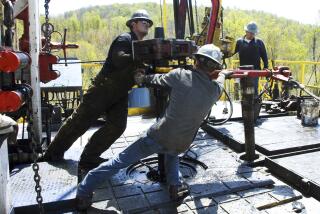Keystone XL rival Enbridge avoids scrutiny of oil pipeline plans
- Share via
ANN ARBOR, Mich. — A major rival to the controversial Keystone XL oil pipeline project is vastly boosting its U.S. pipeline system, but it’s avoiding the same scrutiny that federal regulators, environmentalists and landowners are giving Keystone owner TransCanada Corp.
Enbridge Inc. is proceeding largely unencumbered with plans to spend $8.8 billion in the U.S. to transport greater volumes of petroleum to the Gulf Coast and other markets than TransCanada would with its Keystone XL pipeline project from Alberta, Canada, to the Gulf Coast.
Rather than building a single new pipeline, Enbridge is replacing smaller, existing pipeline with bigger pipes, adding pumping capacity and installing new supply lines alongside existing ones.
The Calgary, Alberta, energy pipeline and storage company is forging ahead even though it has been bedeviled recently by high-profile oil spills.
TransCanada’s Keystone XL plan, and its additional 830,000 barrels a day, snagged on the so-called presidential permit process, in which the State Department conducts environmental and other reviews of infrastructure projects that cross American borders.
But Enbridge, which runs the longest pipeline system in Canada and the U.S., can proceed without new presidential permits — and the rigorous review they bring — because the company already has permits from the initial construction years ago and because the physical work will take place in the United States.
“We can increase the capacity crossing the border by anywhere from 800,000 barrels a day to 1 million barrels a day without the need for a new presidential permit,” Steve Wuori, president of the company’s liquid pipeline division, said during a March 7 investor conference call.
“And I think that’s very important in the politically charged environment in which we find ourselves,” he said.
The task of determining the safety or wisdom of Enbridge pipeline routes falls on a patchwork of local, county and state jurisdictions through the Midwest and East, most of which lack intensive pipeline expertise.
“All these companies are going, ‘How are we going to get oil from Canada to U.S. refineries without this mess? How do we avoid the political issues?’” said Brigham A. McCown, former head of the top federal pipeline regulator and attorney of international energy transportation law.
“And the answer is, find an existing pipeline that crosses the border and add capacity to that pipeline. It’s no different from taking a two-lane road and turning it into a four-lane highway.”
Enbridge, which earned nearly $1 billion last year, has not attracted the national attention of the Keystone XL project largely because of the piecemeal — and still early — nature of its upgrades. Only a few environmental groups have raised alarms thus far.
Yet some of the projects would be significant.
The company aims to build a larger line alongside its pipeline from Flanagan, Ill., to Cushing, Okla.; add a line alongside a newly acquired pipeline that runs from Cushing to the Texas Gulf Coast, a project that it’s splitting with another pipeline company; and increase the capacity of a line from northwest Indiana through Michigan. Smaller projects are planned as well.
Most of the changes are expected to be finished in 2014. Once completed, they would push an additional 310,000 barrels a day through Michigan toward Ontario and take 850,000 barrels a day to the Gulf Coast.
Enbridge spokeswoman Lorraine Little said the company’s upgrades aren’t an attempt to avoid the scrutiny that fell upon Keystone XL; they’re driven by surging oil demand in different parts of North America.
“The process is what it is,” she said. “We have to abide by what’s been laid out for us in order to complete a project. And so if it means going state by state and complying with their regulatory requirements, that’s what we have to do.”
Enbridge’s recent spills raise questions about its safety record.
The company was recently fined $3.7 million for a Marshall, Mich., spill that dumped 20,082 barrels of oil in the Kalamazoo River in 2010, the biggest penalty ever from the nation’s pipeline authority, the U.S. Transportation Department’s Pipeline and Hazardous Materials Safety Administration.
In July, an Enbridge pipeline in Wisconsin spewed 1,200 barrels of oil, and U.S. pipeline regulators reiterated “long-standing concerns” about the company’s “pattern of failures.”
According to company data collected by the Polaris Institute, a left-leaning Canadian think tank, Enbridge has leaked 161,475 barrels of oil in 804 spills from 1999 to 2010.
Enbridge said it has learned from the Marshall spill.
“We as a company have taken a look to see what we can do to prevent that from happening again,” Little said. “I would say that’s the No. 1 goal — to prevent another Marshall incident. We’ve undertaken a lot of initiatives since that incident occurred.”
Against such a backdrop, federal regulators have had little to say. The EPA and the National Transportation Safety Board have declined to comment on Enbridge’s new plans.
The pipeline safety administration is responsible for assuring safe design, construction and operation of pipelines, but it has no say over where lines are built.
As for the State Department, it has no guidelines for pipeline companies to apply for new permits on existing routes that cross the U.S. border. It recommends a new permit if the upgrade is “substantial,” but Enbridge has not yet tried to obtain one.
The company said its plans to boost the Michigan line’s capacity — the same line that spilled into the Kalamazoo River — from the current 240,000 barrels a day to 500,000 barrels a day doesn’t require a new presidential permit even though the line sends oil into Ontario.
“Liquid pipelines don’t really have any of the federal oversight on routing that natural gas lines do,” said Carl Weimer, executive director of the Pipeline Safety Trust, a watchdog group in Bellingham, Wash. “This seems to be one of those big holes in the system.”
The responsibility for determining what can and can’t be done now falls on often highly constrained or inexperienced local authorities.
Landowners and environmentalists have held up TransCanada’s Keystone XL pipeline primarily by objecting to its northern segment from Canada through the sensitive Nebraska Sand Hills and over the Ogallala Aquifer, the main source of potable water for much of the Midwest.
The State Department’s decision on that segment is expected by early next year. Meanwhile, TransCanada is proceeding with a 485-mile southern segment from Oklahoma to the Gulf Coast and can avoid State Department permission, much as Enbridge has done.
Nearly all of Enbridge’s projects would thread through rivers, creeks, fields and wildlife habitats, and Enbridge needs to negotiate with landowners even though the new pipelines and expansion projects would stick closely to existing pipeline pathways.
But without the political megaphone given to them by the presidential permit process, residents and environmentalists opposed to individual projects have been cut off from one another.
“Though we’ve expressed concerns to anyone who will listen, local and state officials seem unmoved,” said Katy Bodenmiller, a resident of the Groveland Township in Michigan who lives along an Enbridge pipeline slated for upgrades.
Other project opponents said that Enbridge has been trying to avoid attention that would bring coordinated opposition to its work.
Little, the Enbridge spokeswoman, said the company has held several town hall meetings on the issue and sent letters to residents and placed ads in local newspapers.
“We do our best,” Little said. “We follow all the rules that are put out by the regulatory authorities, plus the one-on-one contact with landowners. It does make it hard for people to not know what’s going on.”
Pearce, a special correspondent, reported from Ann Arbor; Banerjee from Washington.
More to Read
Inside the business of entertainment
The Wide Shot brings you news, analysis and insights on everything from streaming wars to production — and what it all means for the future.
You may occasionally receive promotional content from the Los Angeles Times.












